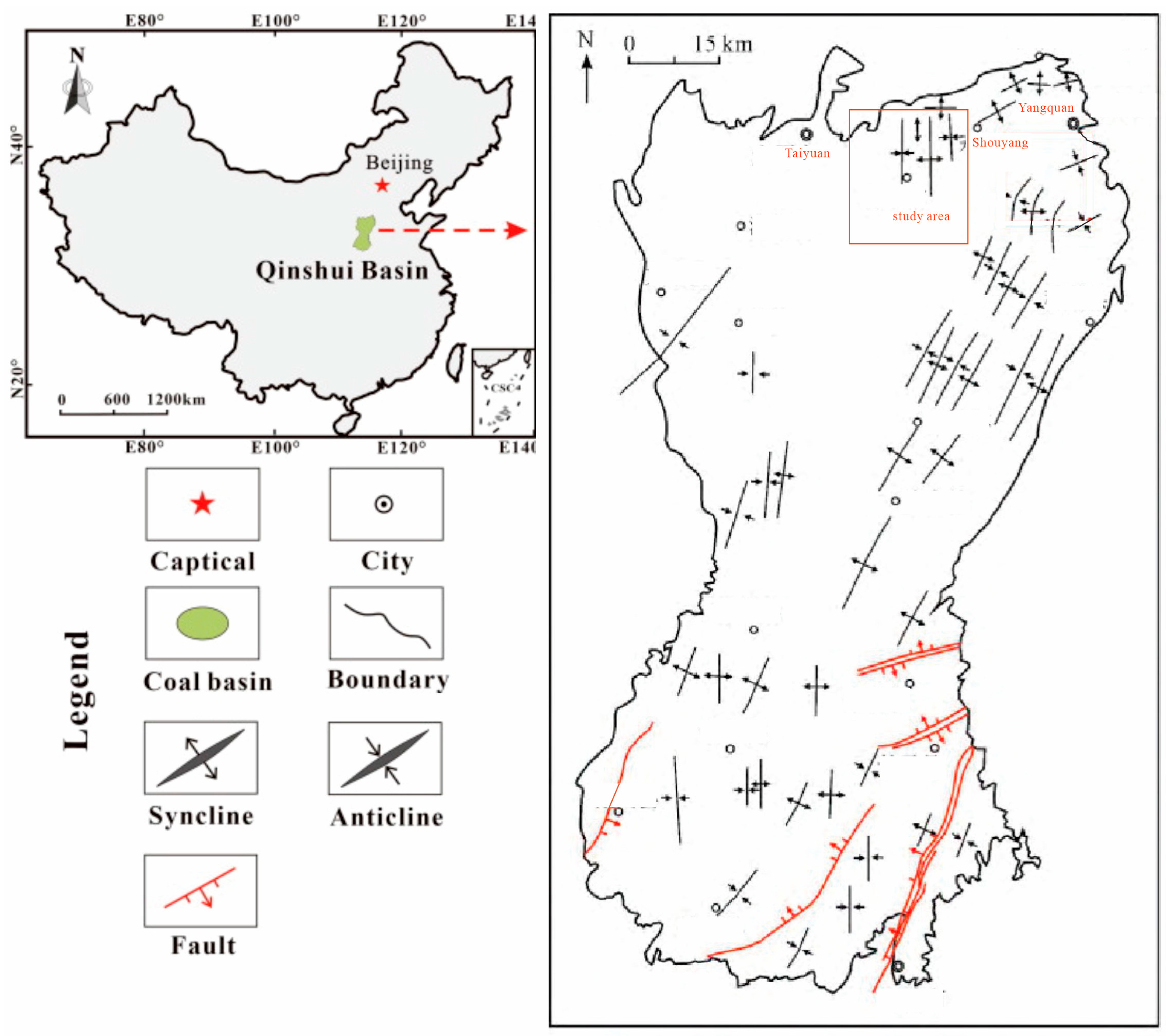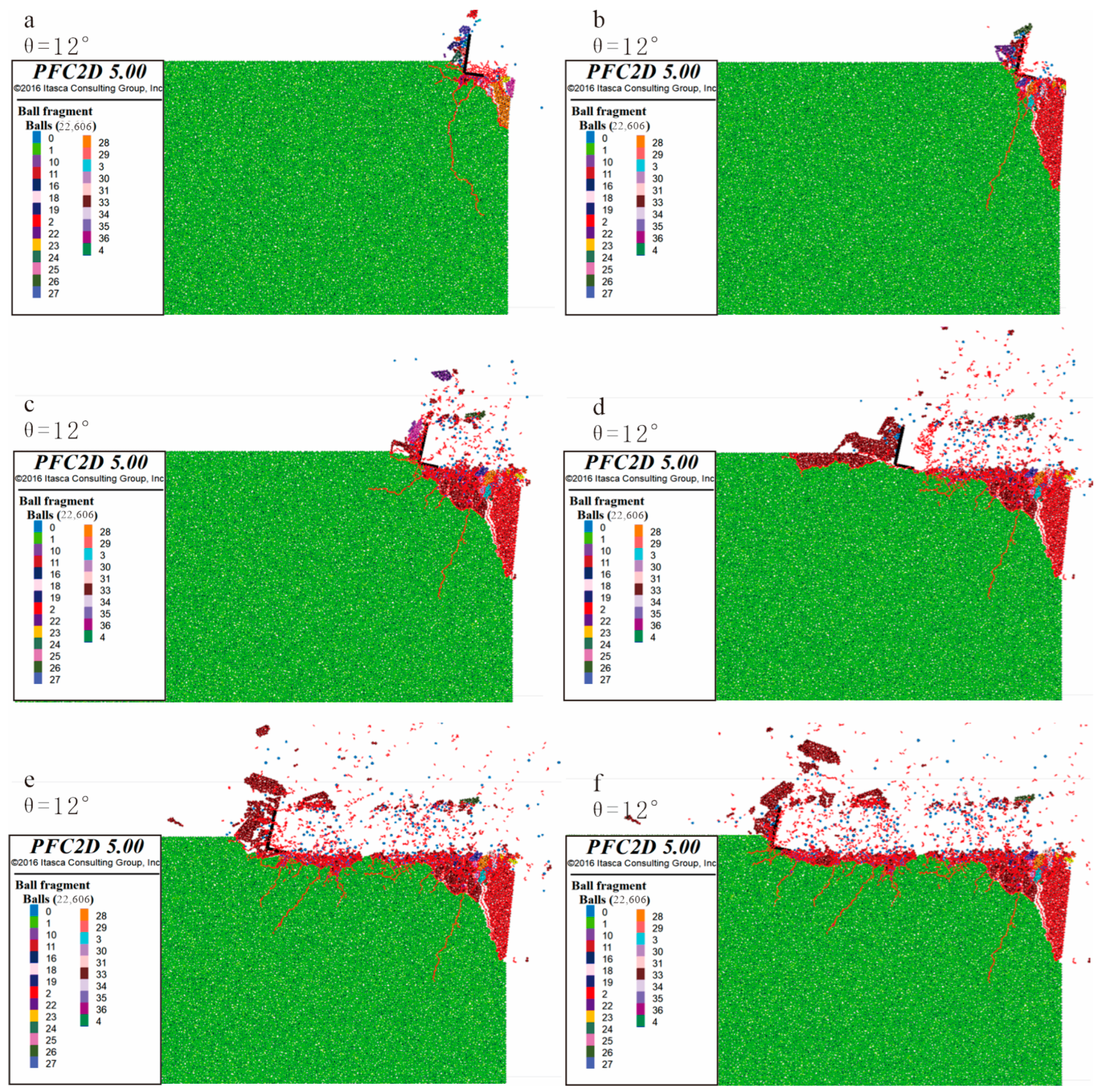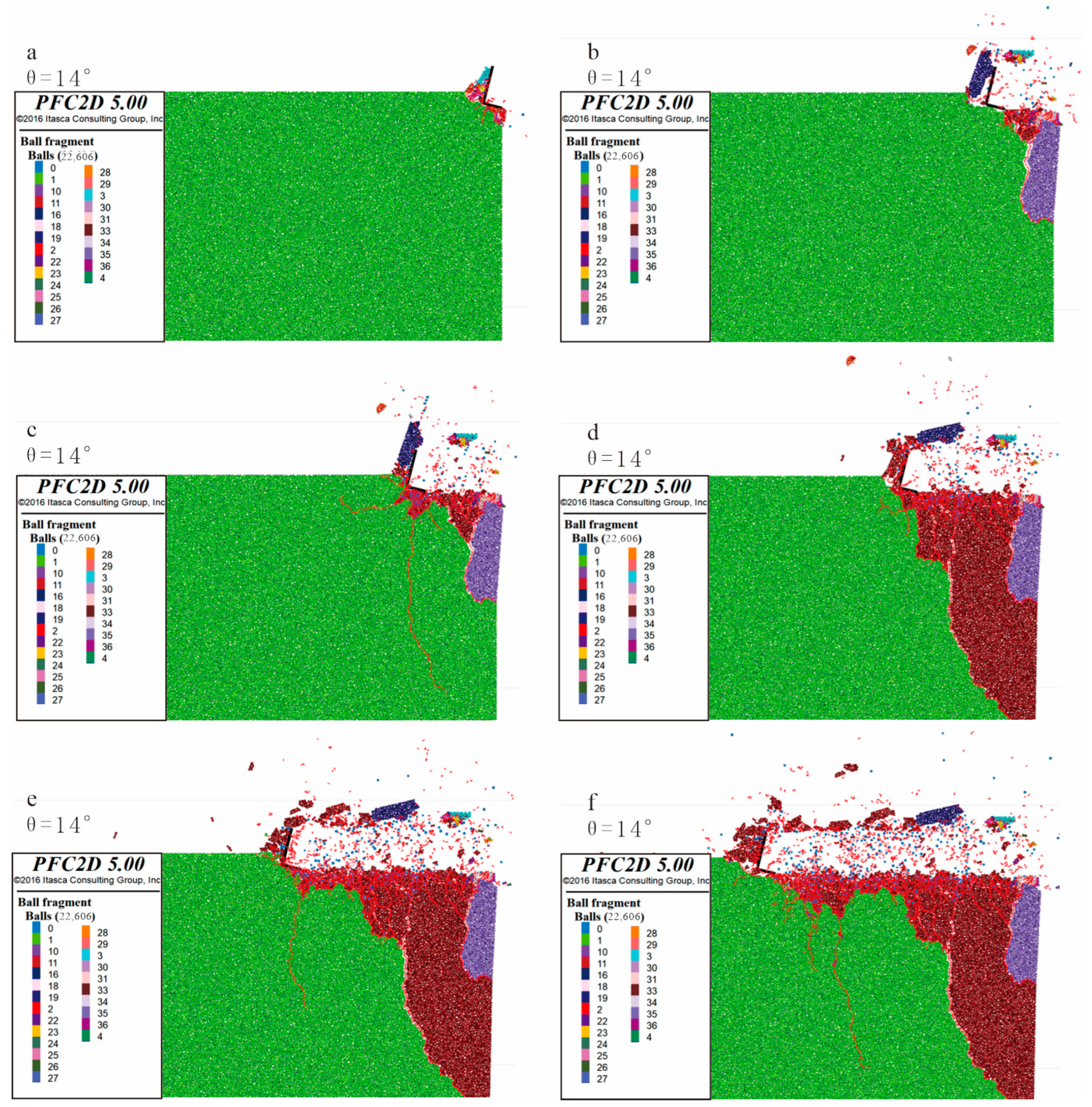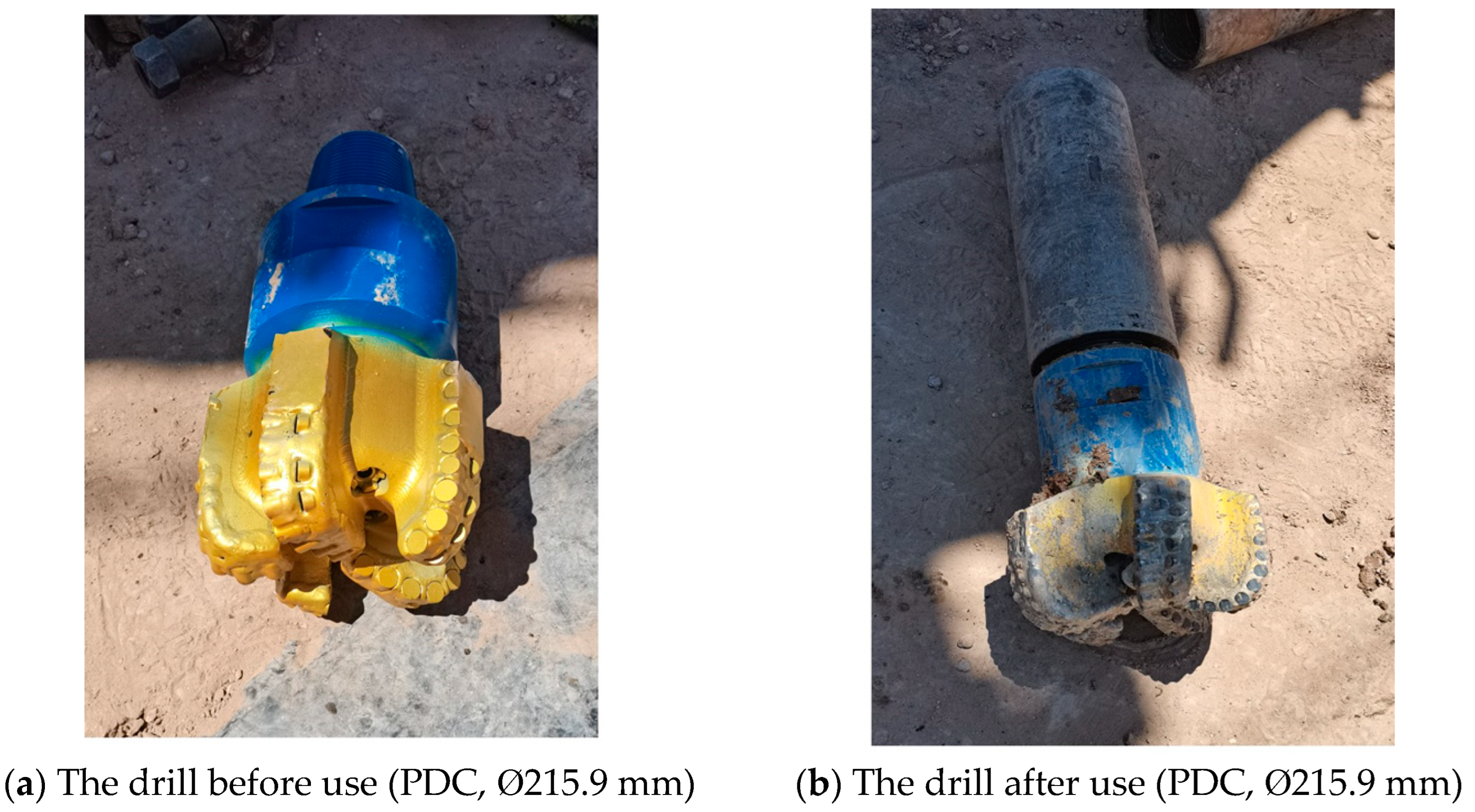Simulation Research and Practical Application of Cutting Teeth for Drill Bits in Life-Support Holes
Abstract
:1. Introduction
2. Overview of the Study Area
3. Rock Mechanics Characteristics of Strata
4. Simulation Analysis of Drill Cutting Teeth
4.1. Parameter Calibration
4.2. Analysis of Rock Cutting Morphology
4.3. Analysis of Rock Cutting Crack Number
4.4. Rock Cutting Rock Breaking Specific Work
5. Engineering Practice
6. Conclusions
- (1)
- The Shouyang mining area is dominated by medium–fine sandstone plus mudstone and siltstone. The formation hardness is medium–soft, and the local formation is hard. The compressive strength of the bedrock formation is between 5.87 and 73.17 MPa, with an average of 33.25 MPa. The drillability grade is between 2.8 and 6.6, with an average of 5.1, and the comprehensive evaluation of drillability is good.
- (2)
- A numerical simulation of parallel cutting of rock with conical teeth was established by experimentally testing rock mechanics parameters and using the discrete element method (PFC2D). The cutting morphology, number of cutting cracks, and specific work of rock breaking at different cutting angles during the rock cutting process were studied, and it was determined that the rock-entering angles of the drill bit cutting teeth suitable for the Shouyang mining area is 14°.
- (3)
- Based on the simulation analysis results of the cutting teeth of the drill bit, the PDC bit was made with the cutting teeth of the drill bit entering the rock at an angle of 14°, and the practical application was carried out. The optimized bit has stable performance, strong cutting ability, and good wear resistance. The maximum instantaneous mechanical drilling speed reaches 58.14 m/h, and it is slightly worn after continuous drilling in the formation for 582 m, which can meet the construction requirements of the life-guarantee hole.
Author Contributions
Funding
Data Availability Statement
Acknowledgments
Conflicts of Interest
References
- Zhang, B.; Kang, Y.G.; Huang, Y.; Zhang, M.; Zhou, G.; Ren, Y.; Liu, J.; Gao, K.; Zhao, Y. Key technologies of surface efficient life support hole forming for mine rescue. Coal Geol. Explor. 2022, 50, 14–23. [Google Scholar] [CrossRef]
- Kang, Y.G.; Zhang, B.; Zhang, M. Key technology and application of surface life support hole demonstration project in Meihuajing Mine. Saf. Coal Mines 2022, 53, 113–120. [Google Scholar]
- Tian, H.L.; Zou, Z.J.; Hao, S.J.; Cao, M.; Zhou, G.; Huang, Y.; Gu, H.; Wang, L. Key technologies and equipment of quickly and safely building life support and rescue channel in mine disastery. Coal Geol. Explor. 2022, 50, 2. [Google Scholar] [CrossRef]
- Zare-Reisabadi, M.R.; Kaffash, A.; Shadizadeh, S.R. Determination of optimal well trajectory during drilling and production based on borehole stability. Int. J. Rock Mech. Min. Sci. 2012, 56, 77–87. [Google Scholar] [CrossRef]
- Boukredera, F.S.; Hadjadj, A.; Youcefi, M.R. Drilling vibrations diagnostic through drilling data analyses and visualization in real time application. Earth Sci. Inform. 2021, 14, 1919–1936. [Google Scholar] [CrossRef]
- Bout, G.; Brito, D.; Gómez, R.; Carvajal, G.; Ramírez, G. Physics-Based Observers for Measurement-While-Drilling System in Down-the-Hole Drills. Mathematics 2023, 10, 4814. [Google Scholar] [CrossRef]
- He, J.-F.; Zhao, Z.-Q.; Yin, Q.-L.; Luo, Y.-J.; Gan, X. Design and optimisation on rapid rescue well-drilling technology with large-diameter pneumatic hammers. Int. J. Min. Reclam. Environ. 2019, 34, 19–33. [Google Scholar] [CrossRef]
- Dehnert, J.; Stopp, J.; Windisch, P.; Schönherrt, B. Quick-Erect Stopping System for radiation protection and mine rescue in small-scale mining. Minning Metall. Explor. 2020, 37, 1807–1817. [Google Scholar]
- Zheng, X.; Wang, H.; Guo, J.; Zhang, D. Method for multi-information drilling detection after mining disasters. Comput. Electr. Eng. 2020, 86, 106726. [Google Scholar] [CrossRef]
- Liu, L.; Zhou, J.; Kong, L.; Wang, Y.; Li, J. Analysis of the dynamic response and impact parameters of pneumatic down-the-hole hammer drilling rescue holes. Geoenergy Sci. Eng. 2023, 228, 211935. [Google Scholar] [CrossRef]
- Zhao, J.Z.; Shi, B.H. Division of coalbed methane-enriched units in the Qinshui Basin. Chin. Sci. Bull. 2005, 50, 140–145. [Google Scholar] [CrossRef]
- Wang, B.; Zhang, Q.; Qu, Z.; Zhang, Y. South Anze Structure and Its Control on Coalbed Methane Aggregation in the Qinshui Basin and the Mechanism of Syncline Gas Enrichment in the Qinshui Basin. Energies 2023, 16, 4521. [Google Scholar] [CrossRef]
- Han, X.M.; Xue, L.B.; Xu, J. Influence mechanism of polycrystalline diamond compact bit temperature rise based on thermo-fluid-solid coupling. Sci. Prog. 2023, 106, 00368504231214704. [Google Scholar] [CrossRef]
- Zhang, Z.; Zhao, D.; Zhao, Y.; Zhou, Y.; Tang, Q.; Han, J. Simulation and experimental study on temperature and stress field of full-sized PDC bits in rock breaking process. J. Pet. Sci. Eng. 2019, 186, 106679. [Google Scholar] [CrossRef]
- Gao, K.; Xu, X.; Jiao, S.; Li, Z. Modeling and experimental research on temperature field of full-sized PDC bits in rock drilling and coring. Energy Rep. 2022, 8, 8928–8938. [Google Scholar] [CrossRef]
- Wang, X.R.; Zhang, H.; Zhang, K.S. Rock breaking simulation and optimization design of multi-ridged PDC cuters. J. China Univ. Pet. 2022, 46, 63–71. [Google Scholar]
- Li, Y.C. Research status on rock-breaking mechanism and performance testing methods of PDC bit cutters. Diam. Abras. Eng. 2023, 43, 553–567. [Google Scholar] [CrossRef]
- Pang, Z.Y.; Xing, X.S.; Wu, Z.Q.; Ma, M.Y.; Mao, L.J. Experimental study on rock breaking by full-size PDC bit in heterogeneous layer. Exp. Technol. Manag. 2023, 40, 44–51. [Google Scholar] [CrossRef]
- Zhu, X.H.; Dan, Z.W. Numerical simulation of rock breaking by PDC cutters in hot dry rocks. Nat. Gas Ind. 2019, 39, 125–134. [Google Scholar]
- Cai, C.; Tan, Z.B.; Xuan, L.C.; Yang, Y.X.; Ren, H.T.; Pu, Z.C.; Zhang, P.; Xie, S. A study on drilling breakage and rock breaking mechanism by using separated impact-scraping and cutting compound bit. J. Vib. Shock 2022, 41, 232–241. [Google Scholar]
- Bazaluk, O.; Velychkovych, A.; Ropyak, L.; Pashechko, M.; Pryhorovska, T.; Lozynskyi, V. Influence of Heavy Weight Drill Pipe Material and Drill Bit Manufacturing Errors on Stress State of Steel Blades. Energies 2021, 14, 4198. [Google Scholar] [CrossRef]
- Yang, Y.; Yang, Y.X.; Ren, H.T.; Qi, Q.L.; Huang, Z.Q.; Zhou, C.X. Experimental study on motion and mechanical characteristics of the vertical wheel in the rock-breaking process. Pet. Sci. 2023, 20, 495–506. [Google Scholar] [CrossRef]
- Yu, J.P.; Zou, D.Y.; Liu, X.A.; Zhang, Y. Simulation and Experimental Study on Hybrid Bit with Different Cutters. Int. J. Simul. Model. 2021, 20, 87–98. [Google Scholar] [CrossRef]
- Niu, S.; Li, Y.; Xie, B.; Yang, Y.; Li, G.; Huang, K. Unit experimental and numerical simulation study on rock breaking mechanism of disc-like hybrid bit. Geoenergy Sci. Eng. 2023, 228, 212006. [Google Scholar] [CrossRef]
- Huang, K.L.; Ai, Z.J.; Yang, Y.X. Working characteristics research on the impacting–cutting hybrid bit. Adv. Mech. Eng. 2019, 11, 168781401985094. [Google Scholar] [CrossRef]
- Ayop, A.Z.; Bahruddin, A.Z.; Maulianda, B.; Prakasan, A.; Dovletov, S.; Atdayev, E.; Rani, A.M.A.; Elraies, K.A.; Ganat, T.A.-A.; Barati, R.; et al. Numerical modeling on drilling fluid and cutter design effect on drilling bit cutter thermal wear and breakdown. J. Pet. Explor. Prod. Tecnol. 2020, 10, 959–968. [Google Scholar] [CrossRef]
- Sun, R.J.; Ju, P.; Shi, Z.J. Simulation study of new directional drilling PDC bit used in coal mine. Geosyst. Eng. 2017, 20, 142–148. [Google Scholar] [CrossRef]
- Zhang, X.; Li, X.; Gao, K.D.; Zeng, Q.L. Analysis of Different Positional Relationships of Adjacent Double Picks on Cutting Force. Int. J. Simul. Model. 2022, 21, 651–662. [Google Scholar] [CrossRef]
- Wu, Z.B.; Yuan, Y.F.; Zhang, W.X.; Huang, J.J. Numerical simulation of rock breaking with intelligent bionic PDC Bit. Sci. Technol. Eng. 2023, 23, 6870–6880. [Google Scholar]
- Kuang, Y.C.; Zhang, M.M.; Feng, M.; Guo, C.; Zhang, Y. Simulation Model of PDC Tooth Cutting Rock and Experimental Research on the Bit. Chin. J. Undergr. Space Eng. 2018, 14, 1218–1225. [Google Scholar]
- Peng, Q.; Zhou, Y.C.; Zhou, B.; Liu, C.; Liu, Y. Development and Field Test of a Non-Planar Cutter PDC Bit with Convex Ridges. Pet. Drill. Tech. 2020, 48, 49–55. [Google Scholar]
- Tian, H.; Ren, H.; Song, D.; Yang, Y. Research on cutting track and working load of directional drilling PDC bit. J. Pet. Sci. Eng. 2021, 208, 109480. [Google Scholar] [CrossRef]
- Chen, L.; Li, D.; He, J.; Meng, L.; Chi, Q.; Li, G.; Chen, W.; Zhao, Y.; Yi, X.; Xia, C. Study on the mechanism of multidimensional cutting teeth and the influencing factors of rock breaking efficiency. PLoS ONE 2024, 19, e0297176. [Google Scholar] [CrossRef] [PubMed]
- Wang, M.; Cao, P. Calibrating the Micromechanical Parameters of the PFC2D(3D) Models Using the Improved Simulated Annealing Algorithm. Math. Probl. Eng. 2017, 2017, 6401835. [Google Scholar] [CrossRef]
- Yuan, L.-W.; Li, S.-M.; Peng, B.; Chen, Y.-M. Study on Failure Process of Tailing Dams Based on Particle Flow Theories. Int. J. Simul. Model. 2015, 14, 658–668. [Google Scholar] [CrossRef]
- Haeri, H.; Sarfarazi, V.; Marji, M.F. Static and Dynamic Response of Rock Engineering Models. Iran. J. Sci. Technol. Trans. Civ. Eng. 2021, 46, 327–341. [Google Scholar] [CrossRef]
- Yilmaz, N.G.; Yurdakul, M.; Goktan, R. Prediction of radial bit cutting force in high-strength rocks using multiple linear regression analysis. Int. J. Rock Mech. Min. Sci. 2007, 44, 962–970. [Google Scholar] [CrossRef]
- Liu, H.J.; Ling, X.; Ma, J.T. Analysis of rock breaking process of single tooth straight cutting based on PFC2D. Drill. Eng. 2023, 50, 156–162. [Google Scholar]











| Stratification | Lithological Description | ||||
|---|---|---|---|---|---|
| Erathem | System | Series | Formation | Designation | |
| Cenozoic erathem | Quaternary system | Pleistocene series | Q | Modern alluvial, diluvium, sand, gravel, clay, etc. | |
| Mesozoic erathem | Triassic system | Lower series | Liujiagou formation | T1l | It is mainly composed of fine-grained feldspar sandstone, sandy mudstone, and siltstone. |
| Paleozoic erathem | Permian system | Upper series | Shiqianfeng formation | P2sh | Sandstone, sandy mudstone, and mudstone. |
| Upper stone box formation | P2s | P2s2+3: fine-grained sandstone and sandy mudstone composition. P2s1: fine-grained sandstone, mudstone, and sandy mudstone. | |||
| Lower series | Lower stone box formation | P1x | P1x2: it is composed of medium- and coarse-grained feldspar quartz sandstone and sandy mudstone, with 1~3 layers of aluminum mudstone at the top. P1x1: sandy mudstone, mudstone, and medium- and fine-grained feldspar quartz sandstone. | ||
| Shanxi formation | P1s | Medium- and fine-grained sandstone and sandy mudstone, mudstone, and coal seams. | |||
| Carboniferous system | Upper series | Taiyuan formation | C3t | C3t3: medium-grained to siltstone, sandy mudstone, mudstone, and coal seams. C3t1: quartz sandstone, sandy mudstone, mudstone, and coal seam. C3t2: limestone, coal seam, sandstone, mudstone, etc. | |
| Middle series | Benxi formation | C2b | Sandy mudstone with sandstone, limestone, and coal line. | ||
| Hole Segment (m) | Rock Name | Compressive Strength (MPa) | Tensile Strength (MPa) | Shear Strength (MPa) | Angle of Internal Friction φ (°) | Cohesion C | Elastic Modulus (105 MPa) | Poisson Ratio |
|---|---|---|---|---|---|---|---|---|
| 570.2 ~571.90 | Silty mudstone | 35.4 | 4.83 | 17.13 | 37.83 | 3.76 | 0.20 | 0.24 |
| 572.33 ~577.95 | Siltstone | 36.6 | 4.36 | 21.25 | 38.91 | 4.03 | 0.22 | 0.20 |
| 580.1 ~581.7 | Fine sandstone | 79.6 | 4.81 | 31.54 | 38.19 | 7.46 | 0.33 | 0.20 |
| 582.7 ~582.96 | Grit stone | 25.5 | 2.07 | 9.48 | 33.45 | 3.64 | 0.11 | 0.24 |
| 583.6 ~585.17 | Fine–medium sandstone | 73.2 | 4.53 | 16.97 | 30.93 | 7.04 | 0.16 | 0.25 |
| 589.15 ~590.30 | Mudstone | 43.7 | 2.80 | 11.22 | 34.91 | 3.34 | 0.12 | 0.22 |
| Particle Parameters | Particle Modulus (Gpa) | Stiffness Ratio | Friction Axis Factor | Density (g/cm3) | Maximum Particle Size (mm) | Minimum Particle Size (mm) |
| 15 | 1.5 | 0.5 | 2.64 | 0.3 | 0.2 | |
| Parallel bond key parameters | Bond modulus (Gpa) | Bond stiffness ratio | Angle of friction (°) | Bonding cohesion (MPa) | Tensile bond strength (MPa) | Bonding generates gap (mm) |
| 15 | 1.5 | 40 | 32 | 64 | 0.04 |
Disclaimer/Publisher’s Note: The statements, opinions and data contained in all publications are solely those of the individual author(s) and contributor(s) and not of MDPI and/or the editor(s). MDPI and/or the editor(s) disclaim responsibility for any injury to people or property resulting from any ideas, methods, instructions or products referred to in the content. |
© 2024 by the authors. Licensee MDPI, Basel, Switzerland. This article is an open access article distributed under the terms and conditions of the Creative Commons Attribution (CC BY) license (https://creativecommons.org/licenses/by/4.0/).
Share and Cite
Zhu, Z.; Feng, J.; Kang, Y.; Zhang, B.; Ling, X. Simulation Research and Practical Application of Cutting Teeth for Drill Bits in Life-Support Holes. Processes 2024, 12, 2130. https://doi.org/10.3390/pr12102130
Zhu Z, Feng J, Kang Y, Zhang B, Ling X. Simulation Research and Practical Application of Cutting Teeth for Drill Bits in Life-Support Holes. Processes. 2024; 12(10):2130. https://doi.org/10.3390/pr12102130
Chicago/Turabian StyleZhu, Zebin, Jian Feng, Yuguo Kang, Biao Zhang, and Xue Ling. 2024. "Simulation Research and Practical Application of Cutting Teeth for Drill Bits in Life-Support Holes" Processes 12, no. 10: 2130. https://doi.org/10.3390/pr12102130





